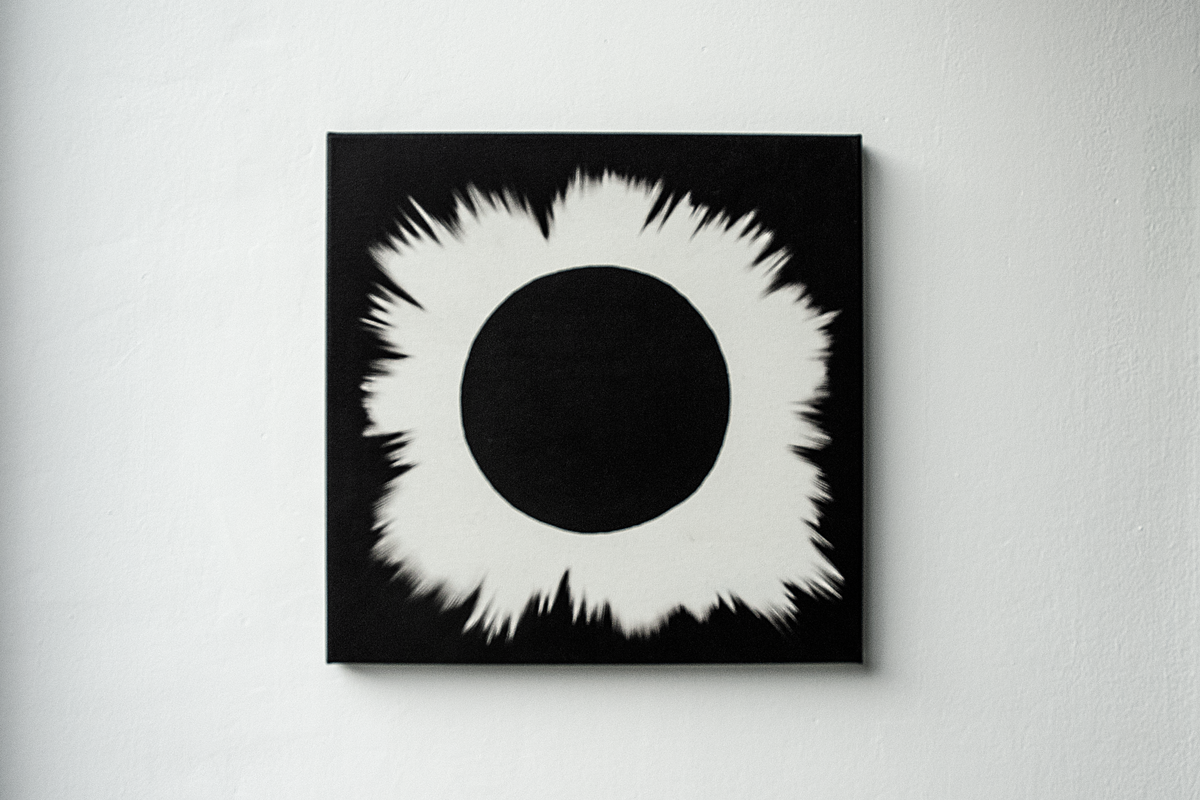Kalendarz lunarny / Lunar Calendar / 2018, seria fotografii / series of photographs / 100 / 100 cm








Seria fotografii Kalendarz lunarny powstała w 2018 roku. W 2021 roku została upubliczniona w ramach indywidualnej wystawy pod tym samym tytułem, w galerii Związku Polskich Artystów Fotografików ZPAF w Krakowie. Kurator wystawy: Danuta Węgiel. / www.zpaf.pl
Fotografie nawiązują do obserwacji faz Księżyca, jego ruchów orbitalnych wokół Ziemi. Widoczność Księżyca z Ziemi związana jest ze zjawiskami przyrodniczymi, załamywaniem się odbijanego przez Księżyc światła i oddziaływaniem sił grawitacyjnych pomiędzy Ziemią, Księżycem a Słońcem. Pełny cykl księżycowy wyznacza pełny miesiąc kalendarzowy, a poszczególne fazy księżyca poszczególne tygodnie. Miesiąc synodyczny trwa około 29,5 doby. Księżyc jako zegar wyznacza pory przypływów i odpływów. Od nowiu do pełni wzrasta, następnie na trzy dni zamiera, po czym maleje aż do całkowitego zaniku — nowiu, który również trwa kolejne dni. Fazy Księżyca (kwadry) wynikają z różnego kąta oświetlenia Księżyca przez Słońce. Księżyc daje światło o wartości 0,1 — 0,3 luksa, w tropikach nawet 1 luks, podobnie jak świeczka. Gdy Księżyc jest widoczny nad linią horyzontu, w daje się większy, niż gdy widzimy go wysoko na niebie. Jest to zjawisko iluzji księżycowej — złudzenie ludzkiego umysłu. Wynika ono z różnicy postrzegania odległość do obiektów na niebie, które są nad nami oraz, które znajdują się na horyzoncie. Kalendarz słoneczny z czasem zastąpił kalendarz księżycowy, ponieważ ten nie był spójny z cyklami pór roku. Dla Słowian kult lunarny pozostawał w bliskim związku z kultem solarnym. Jego symbolika związana była zarówno ze śmiertelnością jak umiejętnością odradzania się.
"...Każdy kalendarz, który od zarania dziejów tworzyli ludzie przekazywał uporządkowaną wiedzę i pozwalał ujrzeć strukturalną powtarzalność zjawisk redukują przy tym poczucie zagubienia i bezsilności. Początkowo podobnie działa elegancka prostota i precyzja, powtarzającej się kompozycji obrazów „Kalendarium” Karoliny Kowalskiej, dając poczucie bezpieczeństwa i wiedzy. Na fotografiach ciemna materia kosmosu jakby upostaciowana przez bujny ogród trwa niezmiennie towarzysząc wszystkim księżycowym wyobrażeniom. Źródło światła prowadzi ku ogrodowi a tafla księżyca mniej lub bardziej uwidacznia jego zarys. W końcu jedna z fotografii pozostawia nas w samym ogrodzie, symboliczne bez światła, w pustce, w której coś się kończy a może zaczyna. W ten sposób pod pozornie rzeczową niemal naukową narracją obrazów wdziera się wyczuwalny klimat niepokoju, pytanie o tajemnicę życia i tego co poza nim. Trwałość ogrodu zmierza się ze zmianami tak jak nasze jednostkowe istnienie musi zmierzyć się z czasem i przemijaniem..."
Danuta Węgiel
The Lunar Calendar photo series was created in 2018. In 2021, it was made public as part of an individual exhibition under the same title, in the gallery ZPAF — Association of Polish Art Photographers in Kraków. Curator of the exhibition: Danuta Węgiel. / www.zpaf.pl
The photographs refer to the observation of the phases of the Moon, its orbital movements around the Earth. The visibility of the Moon from the Earth is related to natural phenomena, the refraction of the light reflected by the Moon and the interaction of gravitational forces between the Earth, the Moon and the Sun. A full lunar cycle determines a full calendar month, and individual phases of the moon determine individual weeks. A synodic month lasts about 29.5 days. The moon as a clock determines the ebb and flow times. From new moon to full moon it increases, then it seems to stay still for three days, and then decreases until it disappears completely till new moon, which also lasts for the next few days. The phases of the moon (quarters) are the result from the different angle of illumination of the Moon by the Sun. The Moon gives light of 0.1 — 0.3 lux, in the tropics even 1 lux, similar to a candle light. When the Moon is visible above the horizon, it appears larger than when we see it high in the sky. This is the lunar illusion phenomenon — a delusion of the human mind. It results from the difference in perception of the distance to objects in the sky that are above us and those that are on the horizon. The solar calendar over time replaced the lunar calendar, because it was not consistent with the cycles of the seasons. For the Slavs, the lunar cult was closely related to the solar cult. Its symbolism was associated with both mortality and the ability to be reborn.
"...Each calendar created by people since the dawn of time conveyed orderly knowledge and allowed to see the structural repetition of phenomena, while reducing the feeling of being lost and powerless. Initially, the elegant simplicity and precision of the repeated composition of Karolina Kowalska's "Calendar" works similarly, giving a sense of security and knowledge. In the photographs, the dark matter of the cosmos, as if embodied by a lush garden, invariably accompanies all lunar images. The light source leads towards the garden and the moon's surface more or less reveals its outline. Finally, one of the photographs leaves us in the garden itself, symbolically without light , in the void where something ends or maybe begins. In this way, under the seemingly factual, almost scientific narrative of the paintings, a perceptible climate of anxiety, a question about the mystery of life and what is beyond, breaks in. The permanence of the garden faces changes just like our individual existence has to face time and passing..."
Danuta Węgiel
































